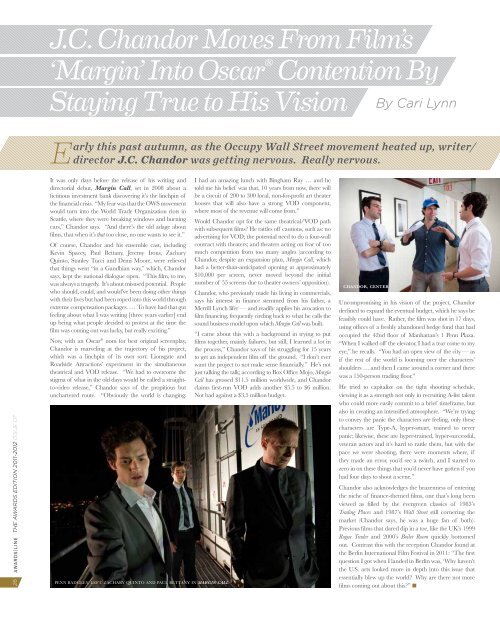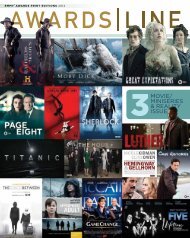THE AWARDS EDITION 2011-2012
THE AWARDS EDITION 2011-2012
THE AWARDS EDITION 2011-2012
- No tags were found...
You also want an ePaper? Increase the reach of your titles
YUMPU automatically turns print PDFs into web optimized ePapers that Google loves.
J.C. Chandor Moves From Film’s‘Margin’ Into Oscar ® Contention ByStaying True to His VisionBy Cari LynnEarly this past autumn, as the Occupy Wall Street movement heated up, writer/director J.C. Chandor was getting nervous. Really nervous.26 The Awards Edition <strong>2011</strong>-<strong>2012</strong> Issue 07It was only days before the release of his writing anddirectorial debut, Margin Call, set in 2008 about afictitious investment bank discovering it’s the linchpin ofthe financial crisis. “My fear was that the OWS movementwould turn into the World Trade Organization riots inSeattle, where they were breaking windows and burningcars,” Chandor says. “And there’s the old adage aboutfilms, that when it’s that too close, no one wants to see it.”Of course, Chandor and his ensemble cast, includingKevin Spacey, Paul Bettany, Jeremy Irons, ZacharyQuinto, Stanley Tucci and Demi Moore, were relievedthat things went “in a Gandhian way,” which, Chandorsays, kept the national dialogue open. “This film, to me,was always a tragedy. It’s about misused potential. Peoplewho should, could, and would’ve been doing other thingswith their lives but had been roped into this world throughextreme compensation packages. … To have had that gutfeeling about what I was writing [three years earlier] endup being what people decided to protest at the time thefilm was coming out was lucky, but really exciting.”Now, with an Oscar ® nom for best original screenplay,Chandor is marveling at the trajectory of his project,which was a linchpin of its own sort: Lionsgate andRoadside Attractions' experiment in the simultaneoustheatrical and VOD release. “We had to overcome thestigma of what in the old days would be called a straightto-videorelease,” Chandor says of the propitious butunchartered route. “Obviously the world is changing.Penn badgley, left, zachary quinto and paul bettany in margin callI had an amazing lunch with Bingham Ray … and hetold me his belief was that, 10 years from now, there willbe a circuit of 200 to 300 local, non-for-profit art theaterhouses that will also have a strong VOD component,where most of the revenue will come from.”Would Chandor opt for the same theatrical/VOD pathwith subsequent films? He rattles off cautions, such as: noadvertising for VOD; the potential need to do a four-wallcontract with theaters; and theaters acting on fear of toomuch competition from too many angles (according toChandor, despite an expansion plan, Margin Call, whichhad a better-than-anticipated opening at approximately$10,000 per screen, never moved beyond the initialnumber of 55 screens due to theater owners’ opposition).Chandor, who previously made his living in commercials,says his interest in finance stemmed from his father, aMerrill Lynch lifer — and readily applies his avocation tofilm financing, frequently circling back to what he calls thesound business model upon which Margin Call was built.“I came about this with a background in trying to putfilms together, mainly failures, but still, I learned a lot inthe process,” Chandor says of his struggling for 15 yearsto get an independent film off the ground. “I don’t everwant the project to not make sense financially.” He’s notjust talking the talk; according to Box Office Mojo, MarginCall has grossed $11.5 million worldwide, and Chandorclaims first-run VOD adds another $5.5 to $6 million.Not bad against a $3.5 million budget.Chandor, centerUncompromising in his vision of the project, Chandordeclined to expand the eventual budget, which he says hefeasibly could have. Rather, the film was shot in 17 days,using offices of a freshly abandoned hedge fund that hadoccupied the 42nd floor of Manhattan’s 1 Penn Plaza.“When I walked off the elevator, I had a tear come to myeye,” he recalls. “You had an open view of the city — asif the rest of the world is looming over the characters’shoulders … and then I came around a corner and therewas a 150-person trading floor.”He tried to capitalize on the tight shooting schedule,viewing it as a strength not only in recruiting A-list talentwho could more easily commit to a brief timeframe, butalso in creating an intensified atmosphere. “We’re tryingto convey the panic the characters are feeling, only thesecharacters are Type-A, hyper-smart, trained to neverpanic; likewise, these are hyper-trained, hyper-successful,veteran actors and it’s hard to rattle them, but with thepace we were shooting, there were moments where, ifthey made an error, you’d see a twitch, and I started tozero in on these things that you’d never have gotten if youhad four days to shoot a scene.”Chandor also acknowledges the brazenness of enteringthe niche of finance-themed films, one that’s long beenviewed as filled by the evergreen classics of 1983’sTrading Places and 1987’s Wall Street still cornering themarket (Chandor says, he was a huge fan of both).Previous films that dared dip in a toe, like the UK’s 1999Rogue Trader and 2000’s Boiler Room quickly bottomedout. Contrast this with the reception Chandor found atthe Berlin International Film Festival in <strong>2011</strong>: “The firstquestion I got when I landed in Berlin was, ‘Why haven’tthe U.S. arts looked more in depth into this issue thatessentially blew up the world? Why are there not morefilms coming out about this?” •











